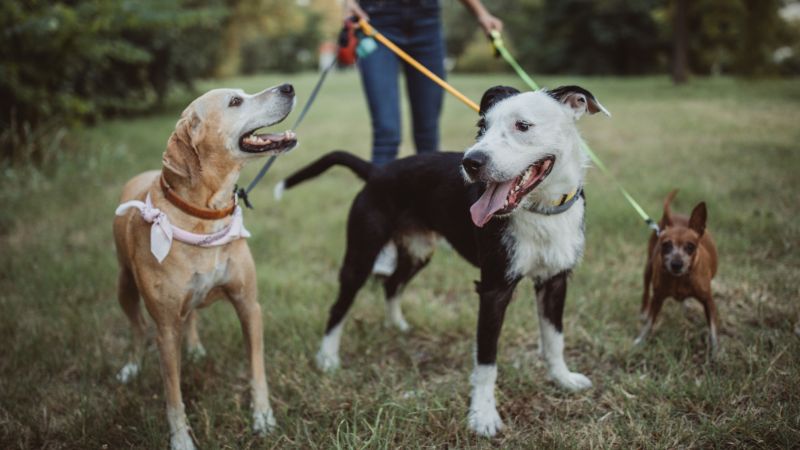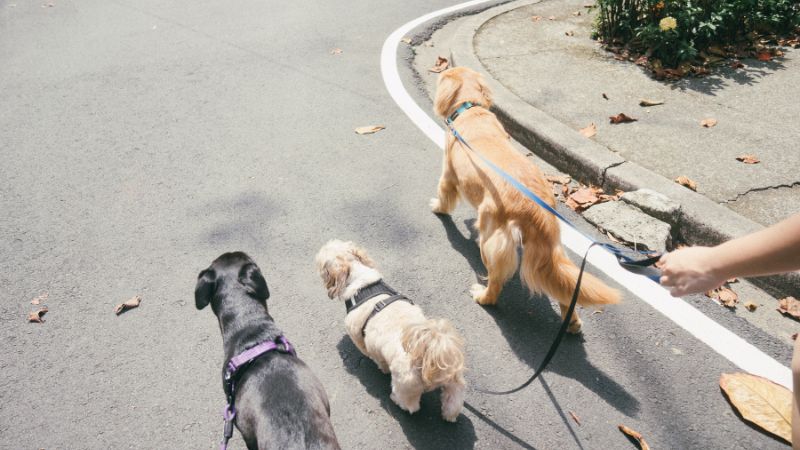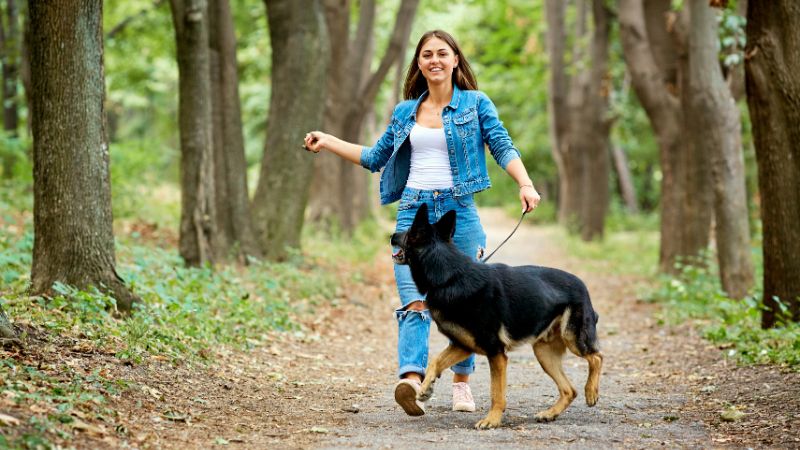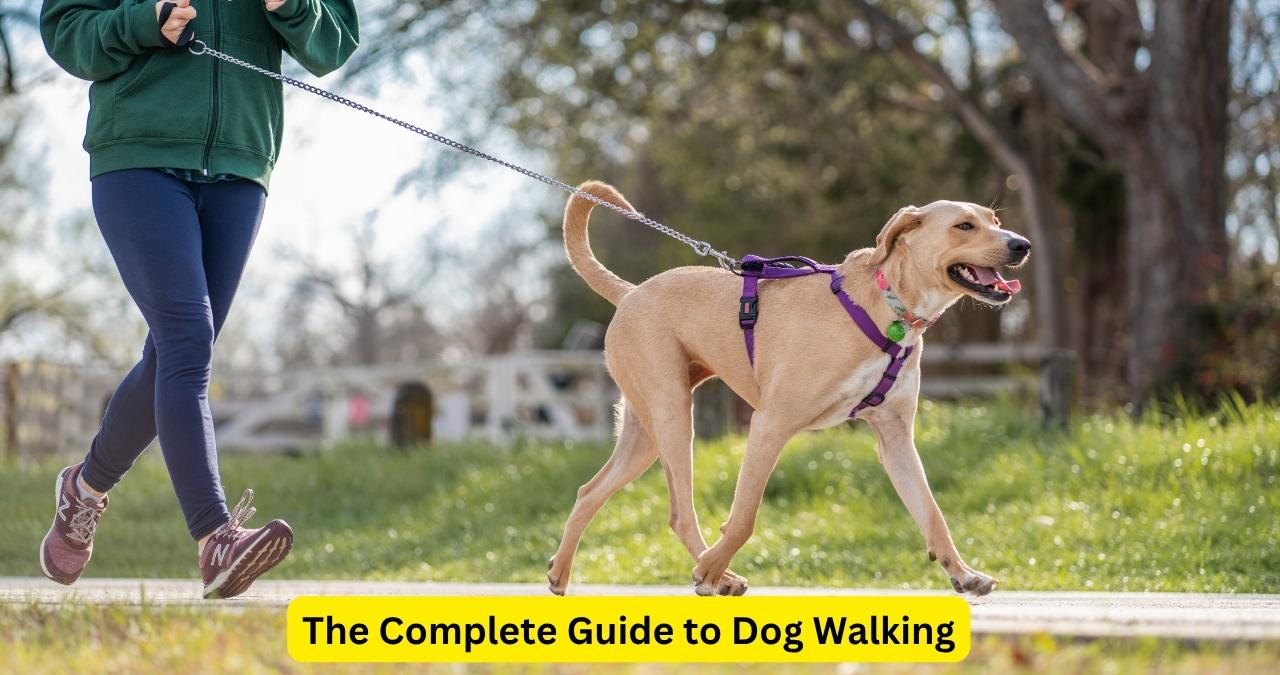Picture this: you grab your dog’s leash, and their tail starts wagging like crazy. That’s the magic of dog walking! It’s not just a daily task—it’s a chance to bond with your furry friend, keep them healthy, and enjoy some fresh air yourself. Dog walking is essential for your dog’s physical and mental well-being, and it’s a fantastic way for you to stay active and reduce stress. In 2025, dog walking has become even more exciting with new technologies, stylish gear, and a focus on sustainability. Whether you’re a new pet owner, a seasoned dog lover, or thinking about starting a dog walking business, this guide has everything you need to make every walk a pawsitive experience.
In this blog, we’ll explore the benefits of dog walking, share practical tips for getting started, highlight safety must-knows, recommend the best gear, and dive into the latest trends shaping dog walking in 2025. Let’s lace up our shoes, grab the leash, and get started!
Table of Contents
ToggleWhy Dog Walking Matters
Dog walking is more than just a quick trip around the block. It’s a cornerstone of your dog’s health and happiness, and it offers surprising benefits for you too. Here’s why it’s so important:
For Your Dog: Regular walks keep your dog fit, mentally stimulated, and well-behaved. They get to explore new sights and smells, which is like a daily adventure for their curious minds.
For You: Walking your dog gets you moving, boosts your mood, and can even help you make new friends in your community.
For Your Bond: Those shared moments on the trail or sidewalk strengthen the connection between you and your pup.
With 70% of U.S. households owning a pet and 69 million owning dogs, according to the American Pet Products Association, dog walking is a daily ritual for millions. Let’s dive into the specific benefits to understand why it’s worth making time for.
Benefits of Dog Walking
Dog walking is a win-win for both you and your furry companion. Here’s a closer look at how it helps:

For Your Dog
Physical Health: Walks help maintain a healthy weight, reducing the risk of obesity-related issues like heart disease and joint problems. About 50% of dogs in the U.S. are overweight, and regular exercise can prevent this, according to VCA Animal Hospitals.
Mental Stimulation: Exploring new environments provides mental exercise, reducing stress and boredom. This can prevent destructive behaviors like chewing or excessive barking.
Behavioral Benefits: Burning off energy through walks makes dogs calmer at home. It also helps with socialization, as they learn to interact with other dogs and people.
Immune Boost: Exposure to outdoor environments can strengthen your dog’s immune system, as noted by FitBark.
For You
Physical Fitness: Walking your dog counts as exercise, improving cardiovascular health, lowering blood pressure, and strengthening muscles. Research from Better Health Channel shows dog owners are more likely to meet weekly exercise goals.
Mental Health: Time outdoors with your dog releases endorphins, reducing stress and boosting mood. It also provides a sense of routine and purpose.
Social Connections: Dog walking often sparks conversations with other pet owners, helping you build community ties and combat loneliness.
Motivation: Your dog’s eager eyes are the perfect nudge to get you moving, even on tough days.
Example: Sarah, a busy professional, found that walking her Labrador, Max, every evening helped her unwind after work. Not only did Max become calmer at home, but Sarah also lost 10 pounds and made new friends at the dog park!
Key Takeaway: Dog walking is a simple way to improve your dog’s health and your own well-being while strengthening your bond.
How to Start Dog Walking
Whether you’re walking your own dog or considering a dog walking business, here’s how to get started.
For Pet Owners
Starting a dog walking routine is easy with a few simple steps:
Choose the Right Gear: Invest in a sturdy 4-6 foot leash, a well-fitting collar or harness, and poop bags. Harnesses are great for dogs that pull, as they reduce neck strain.
Train Your Dog: Use positive reinforcement (treats and praise) to teach your dog to walk calmly on a leash. Start in a quiet area to build confidence.
Plan Your Walks: Pick times that work for your schedule, like early morning or evening to avoid heat. Choose safe, familiar routes.
Be Consistent: Aim for at least one 30-minute walk daily, though active breeds may need more. Consistency keeps your dog happy and healthy.
Example: When John adopted his rescue dog, Bella, she pulled on the leash constantly. By starting with short walks in a quiet park and rewarding her with treats for staying close, John helped Bella become a pro at walking within a month.
For Starting a Dog Walking Business
The dog walking industry is booming, with a U.S. market size of $1.7 billion in 2025, according to IBISWorld. Here’s how to launch your own business:
Research the Market: Check local demand and identify your target clients, like busy professionals or elderly pet owners.
Get Legal: Register your business, obtain licenses, and secure liability insurance. Check local regulations for permits.
Set Rates: Research local rates (average $33.26 per walk in the U.S., per Pet Sitter Dashboard) and offer competitive pricing.
Market Your Services: Use social media, local flyers, and platforms like Rover to attract clients. A professional website can help too.
Learn Safety: Get trained in pet first aid and learn to handle multiple dogs safely.
Invest in Gear: Use multi-dog leashes and safety vests for professional walks.
Example: Katie, a dog walker in Virginia, started Paw Inclusive by advertising on Nextdoor and offering group walks. Within a year, she had a steady client base and expanded to pet sitting.
Key Takeaway: Whether you’re walking your own dog or starting a business, preparation and consistency are key to success.
Dog Walking Safety Tips

Safety comes first when walking your dog. Here are 10 essential tips to keep you and your pup safe:
Carry Identification: Ensure your dog wears a collar with ID tags and consider microchipping for extra security (VCA Animal Hospitals).
Use a Sturdy Leash: Choose a 4-6 foot leash over retractable ones for better control.
Train for Leash Walking: Use positive reinforcement to teach your dog to walk calmly, reducing the risk of pulling or escaping.
Bring Water: Carry water for both you and your dog, especially on hot or long walks, to prevent dehydration.
Check Weather Conditions: Avoid walking on hot pavement (test with your hand) and limit exposure in extreme cold.
Use Reflective Gear: For night walks, use reflective vests or collars to improve visibility (Kinship).
Plan Your Route: Stick to familiar, safe paths and avoid areas with heavy traffic or wildlife.
Respect Other Dogs: Don’t let your dog approach others without permission to avoid conflicts.
Be Aware of Surroundings: Watch for cyclists, joggers, or wildlife that might startle your dog.
Handle Aggression Calmly: If you encounter an aggressive dog, stay calm, keep your dog close, and avoid eye contact.
Example: During a winter walk, Lisa noticed her dog, Rusty, shivering. She invested in a warm dog coat and cut the walk short, preventing discomfort and keeping Rusty safe.
Key Takeaway: Prioritize safety with proper gear, awareness, and preparation for a worry-free walk.
Equipment and Gear for Dog Walking
The right gear makes dog walking safer and more enjoyable. Here’s what you need, including 2025 trends:
Must-Have Gear
Leash: A 4-6 foot nylon or leather leash is durable and provides control. Avoid retractable leashes, which can be risky.
Collar or Harness: Harnesses like the Ruffwear Front Range Harness are ideal for pullers, while collars work for well-trained dogs.
Poop Bags: Always carry biodegradable bags to clean up after your dog.
ID Tags: Include your dog’s name and your contact info for safety.
Trending Gear in 2025
Dog Boots: Protect paws from hot pavement or snow with boots like those reviewed by CleverHiker.
Reflective Gear: High-visibility vests and collars ensure safety during night walks.
Hands-Free Leashes: Great for jogging or multitasking, these attach to your waist.
Pet Sportswear: Breathable, water-repellent fabrics with reflective details are trending, as noted by Parisian Pet.
GPS Trackers: Devices like those from Tractive help locate your dog if they wander off.
Eco-Friendly Gear: Sustainable leashes and harnesses made from recycled materials are gaining popularity.
Example: When hiking with her Border Collie, Mia used a dog backpack to carry water and treats, making their adventures more comfortable and fun.
Key Takeaway: Quality gear enhances safety and comfort, while 2025 trends add style and functionality.
Dog Walking Etiquette
Being a considerate dog walker keeps everyone happy. Here are 7 rules to follow:
Keep Your Dog on a Leash: Unless in a designated off-leash area, use a 4-6 foot leash for control (Purina).
Clean Up After Your Dog: Always pick up poop and dispose of it properly.
Respect Others’ Space: Don’t let your dog approach other dogs or people without permission.
Control Behavior: Prevent excessive barking or lunging to avoid disturbing others.
Avoid Private Property: Keep your dog off lawns and gardens to respect neighbors.
Follow Local Laws: Adhere to leash laws and park rules in your area.
Be Mindful: Give space to cyclists, joggers, and other dogs to ensure a peaceful walk.
Example: When Tom’s dog, Buddy, tried to chase a jogger, Tom kept him on a short leash and apologized, maintaining a friendly vibe in the park.
Key Takeaway: Good etiquette makes dog walking enjoyable for everyone in your community.
Dog Walking Trends

Dog walking is evolving with exciting trends:
Technology: Apps like Rover and Wag! simplify booking professional dog walkers. GPS trackers and smart collars monitor your dog’s location and health.
Pet Sportswear: Stylish, functional gear with breathable fabrics and reflective details is a hit, as seen in Parisian Pet’s trends.
Sustainability: Eco-friendly gear made from recycled materials reflects growing environmental awareness.
Health Focus: Owners are prioritizing regular walks for mental and physical health, with 64% of UK dog owners meeting exercise goals through dog walking, per FitBark.
Example: Using a GPS tracker, Emily found her dog, Luna, when she slipped her leash during a walk, saving the day with technology.
Key Takeaway: 2025 brings smarter, greener, and healthier ways to enjoy dog walking.
Conclusion
Dog walking is a simple yet powerful way to keep your dog healthy, happy, and well-behaved while boosting your own physical and mental well-being. From choosing the right gear to following safety tips and embracing 2025 trends, this guide has covered everything you need to make dog walking a rewarding experience. Whether you’re strolling with your pup or starting a dog walking business, consistency and preparation are key. So, grab your leash, try out some new gear, and make every walk an adventure for you and your furry friend.
Final Thoughts: Dog walking is more than exercise—it’s a chance to connect with your dog and your community. Start today and enjoy the journey!
FAQs about Dog Walking
- How often should I walk my dog?
Most dogs need at least one 30-minute walk daily, but active breeds may require more. Puppies and seniors may benefit from shorter, more frequent walks.
- What are the best times to walk my dog?
Early morning or late evening avoids heat and crowds. Adjust based on your schedule and weather conditions.
- How do I train my dog to walk nicely on a leash?
Use treats and praise to reward calm walking. Start in a quiet area and gradually introduce distractions (Sploot Vets).
- What should I do if my dog is afraid of other dogs during walks?
Keep your dog on a leash and avoid forcing interactions. Gradually expose them to other dogs in controlled settings with positive reinforcement.
- Are there any health risks associated with dog walking?
Risks like overheating or injuries are minimal with precautions like hydration, proper gear, and weather awareness.
- How can I make dog walking more enjoyable for my dog?
Vary routes, bring treats, and let them sniff and explore for mental stimulation.
- What gear do I absolutely need for dog walking?
A leash, collar or harness, poop bags, and ID tags are essential. Reflective gear is great for night walks.
- Is it safe to walk my dog at night?
Yes, with reflective gear and well-lit routes. Stay aware of your surroundings (Tractive).
- How do I handle my dog pulling on the leash?
Use a no-pull harness and stop walking when they pull. Reward them for staying close.
- What should I do if I encounter an aggressive dog while walking?
Stay calm, keep your dog close, avoid eye contact, and create distance if possible.








